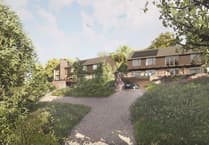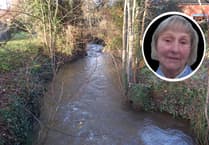LOCALS were given more detail about the options being considered for the future of Cannop Ponds at the first consultation event held by Forestry England yesterday (Tuesday, March 21).
At the drop-in event at the Speech House, Forestry England (FE) staff discussed the four possible solutions with members of the public and, for the first time, people were given the chance to have their say on the matter via a survey.
Many who attended the first session were supporters of the ’Save Cannop Ponds’ campaign who want to see the dams repaired and ponds retained.
Supporters were clad in ‘Save Cannop Ponds’ t-shirts and group members were stationed at the entrance to carry out their own survey, in which attendees were asked what their preferred option is having learned more about them.
Save Cannop Ponds campaign leader Shaun Bick said ahead of the event: “I’m open minded on what the options are, however the main priority is to retain the dams, retain the ponds and leave it as it is with as minor improvement as possible.”
He said the group’s main aim was to get as many of their supporters as possible to leave feedback so that the ponds’ retention had majority support.
Recent inspections of the dams found that the lower spillway would not be able to withstand a one-in-a-150-year flooding event, which if it happened would be devastating for communities downstream in Parkend and Lydney.
Deputy Surveyor for the Forest of Dean Kevin Stannard says that with climate change modelling predicting more rainfall over fewer days in the future, the chance of such a flood happening is becoming “more likely”.
He reiterated at the event that FE has a legal obligation to take action and that “doing nothing is not an option”.
He said that if the ponds were to be retained, the dams would need to be upgraded to a “much bigger structure”.
“When you start looking at that scale of engineering options, rather than just do what’s in front of you, it’s got to be sensible to look at a wider range of options and explore what is actually best for the Forest and best for the valley so that you can design and build something that’s fit for the future”, he said.
The proposed options for the site are:
- A spillway and dam upgrade, which would see the top and the sides of the dams raised and strengthened to allow the ponds to remain as they are now.
- A storm water storage option, which would see the upper pond become and series of smaller ponds and the lower pond retained but dropped by one to two metres.
- A cascade of smaller ponds, which involves the removal of the spillways and the construction of “leaky, woody” structures to hold water.
- The “renaturalising” of the Cannop Brook, which would involve the removal of both spillways to create a mix of grassland and woodland habitats, resulting in the loss of both ponds.
Mr Stannard says that all of the options represent significant changes to the site, but that some bring more benefits than others in terms of biodiversity net gain and storm water storage.
He said: “Ecologically, there’s no doubt that option four is the best, but equally from a storm water attenuation point of view, you can’t necessarily rely on nature alone to deliver that, which is why we need to explore all of these options.
“We need to know what the community are thinking, yes we’ve heard ‘Save Cannop Ponds’ with 50,000 signatures - that’s pretty clear - but while option one delivers what they’re definitely saying, option two presents something close to what they’re saying and a load of other benefits.
“We’ve also got some extensive modelling work to do, because if we’re going to spend £7 million on a solution, we need to make sure it’s the right solution with the objective evidence to support it.”
He explained that any planning application would need to demonstrate biodiversity net gain, and that while Cannop in its current form is wildlife rich, there are some invasive species there along with pollutive sediments from the historic industrial workings.
Asked how much the feedback from the events would influence FE’s decision, he said: “The shear number of people showing passion for the Forest is incredible, its great that people are taking an interest in their local forest.
“But how many of those 50,000 have actually understood the issues around biodiversity net gain, or storm water attenuation or silt management etc.
So it isn’t a public vote, because there’s a lot more technical modelling that needs to be done to see what’s feasible”.
The day consisted of four one-hour sessions which were fully booked out in advance.
Another event is taking place next Thursday (March 30), spaces for which can be reserved online.
Yesterday also saw the launch of FE’s virtual Cannop Ponds engagement, which offers the same information and opportunities to give feeback as the in-person events.
The virtual event runs until April 11 at cannop-ponds.virtual-engage.com.




Comments
This article has no comments yet. Be the first to leave a comment.